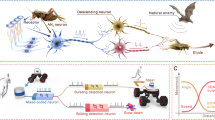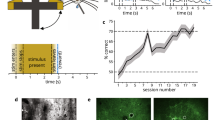Abstract
Understanding abstract concept is a major topic in cognitive science. This complex phenomenon is studied under different approaches, but remains unexplained at the cellular level in a full sensorimotor to behavior model. In this study, an artificial spiking neural circuit is proposed to simulate the same/different (S/D) relational concept through the context of a simple discriminative visual learning task. This computational method is used as a brain controller for virtual and physical robots, reflecting the embodied perspective of the present model. Specifically, with an operant conditioning procedure, the robot learns to associate a correct left/right action from a two items side-by-side image and a positive reinforcer. Following the learning phase, a transfer test is performed and the robot succeeds with pairs of novel stimuli. As novelty, this learning process involving the S/D concept is entirely based on spike timing, synaptic changes and a sensorimotor robot model. This work could serve as a prototype toward the inclusion of other types of relational concepts, possibly sharing similar functional neural circuits.
Access this chapter
Tax calculation will be finalised at checkout
Purchases are for personal use only
Similar content being viewed by others
References
Ahmed, F., Yusob, B., Hamed, H.N.A.: Computing with spiking neuron networks: a review. Int. J. Adv. Soft Comput. Appl. 6, 1–21 (2014)
Avarguès-Weber, A., Giurfa, M.: Conceptual learning by miniature brains. Proc. R. Soc. B Biol. Sci. 280(1772), 1–9 (2013)
Behrends, A., Scheiner, R.: Octopamine improves learning in newly emerged bees but not in old foragers. J. Exp. Biol. 215(7), 1076–1083 (2012)
Bi, G.Q., Poo, M.M.: Activity-induced synaptic modifications in hippocampal culture: dependence on spike timing, synaptic strength and cell type. J. Neurosci. 18, 10464–10472 (1998)
Bing, Z., Baumann, I., Jiang, Z., Huang, K., Cai, C., Knoll, A.: Supervised learning in SNN via reward-modulated spike-timing-dependent plasticity for a target reaching vehicle. Front. Neurorobot. 13, 18 (2019)
Blaisdell, A.P., Cook, R.G.: Two-itemsame-different concept learning in pigeons. Anim. Learn. Behav. 33(1), 67–77 (2005)
Brown, M.F., Sayde, J.M.: Same/different discrimination by bumblebee colonies. Anim. Cogn. 16(1), 117–125 (2013)
Cangelosi, A., Stramandinoli, F.: A review of abstract concept learning in embodied agents and robots. Philos. Trans. R. Soc. B Biol. Sci. 373(1752), 20170131 (2018). https://doi.org/10.1098/rstb.2017.0131. http://rstb.royalsocietypublishing.org/content/373/1752/20170131
Caporale, N., Dan, Y.: Spike timing-dependent plasticity: a hebbian learning rule. Annu. Rev. Neurosci. 31, 25–46 (2008)
Chance, F.S., Aimone, J.B., Musuvathy, S.S., Smith, M.R., Vineyard, C.M., Wang, F.: Crossing the cleft: communication challenges between neuroscience and artificial intelligence. Front. Comput. Neurosci. 14, 39 (2020)
Chittka, L., Jensen, K.: Animal cognition: concepts from apes to bees. Curr. Biol. 21(3), 116–119 (2011)
Chuderski, A., Chuderska, A.: How working memory capacity constrains the learning of relational concepts. In: Proceedings of the Annual Meeting of the Cognitive Science Society, vol. 35 (2013)
Cyr, A., Avarguès-Weber, A., Theriault, F.: Sameness/difference spiking neural circuit as a relational concept precursor model: a bio-inspired robotic implementation. Biol. Inspired Cogn. Archit. 21, 59–66 (2017)
Cyr, A., Boukadoum, M., Poirier, P.: AI-SIMCOG: a simulator for spiking neurons and multiple animat’s behaviours. Neural Comput. Appl. 18(5), 431–446 (2009)
Daniel, T.A., Cook, R.G., Katz, J.S.: Temporal dynamics of task switching and abstract-concept learning in pigeons. Front. Psychol. 6, 1334 (2015)
Foncelle, A., et al.: Modulation of spike-timing dependent plasticity: towards the inclusion of a third factor in computational models. Front. Comput. Neurosci. 12, 49 (2018)
Frémaux, N., Gerstner, W.: Neuromodulated spike-timing-dependent plasticity, and theory of three-factor learning rules. Front. Neural Circuits 9, 85 (2016)
Galizio, M., Mathews, M., Prichard, A., Bruce, K.E.: Generalized identity in a successive matching-to-sample procedure in rats: effects of number of exemplars and a masking stimulus. J. Exp. Anal. Behav. 110(3), 366–379 (2018)
Gerstner, W., Kistler, W.: Spiking Neuron Models: Single Neurons, Populations, Plasticity. Cambridge University Press, Cambridge (2002)
Giurfa, M.: Cognition with few neurons: higher-order learning in insects. Trends Neurosci. 36(5), 259–312 (2013)
Giurfa, M.: Learning of sameness/difference relationships by honey bees: performance, strategies and ecological context. Curr. Opin. Behav. Sci. 37, 1–6 (2021)
Giurfa, M., Zhang, S., Jenett, A., Menzel, R., Srinivasan, M.V.: The concepts of ‘sameness’ and ‘difference’ in an insect. Nature 410(6831), 930–933 (2001)
Izhikevich, E.M.: Simple model of spiking neurons. IEEE Trans. Neural Networks 14(6), 1569–1572 (2003)
Krichmar, J.L.: Neurorobotics-a thriving community and a promising pathway toward intelligent cognitive robots. Front. Neurorobot. 12, 42 (2018)
Kuśmierz, Ł, Isomura, T., Toyoizumi, T.: Learning with three factors: modulating Hebbian plasticity with errors. Curr. Opin. Neurobiol. 46, 170–177 (2017)
Lazareva, O.F., Gould, K., Linert, J., Caillaud, D., Gazes, R.P.: Smaller on the left? Flexible association between space and magnitude in pigeons (Columba livia) and blue jays (Cyanocitta cristata). J. Comp. Psychol. 134(1), 71 (2019)
Lazarowski, L., Goodman, A., Galizio, M., Bruce, K.: Effects of set size on identity and oddity abstract-concept learning in rats. Anim. Cogn. 22(5), 733–742 (2019). https://doi.org/10.1007/s10071-019-01270-5
Markram, H., Lubke, J., Frotscher, M., Sakmann, B.: Regulation of synaptic efficacy by coincidence of postsynaptic APs and EPSEs. Science 275, 213–215 (1997)
Pawlak, V., Wickens, J.R., Kirkwood, A., Kerr, J.N.: Timing is not everything: neuromodulation opens the STDP gate. Front. Synaptic Neurosci. 138 (2010)
Schultz, W.: Predictive reward signal of dopamine neurons. J. Neurophysiol. 80(1), 1–27 (1998)
Smirnova, A.A., Obozova, T.A., Zorina, Z.A., Wasserman, E.A.: How do crows and parrots come to spontaneously perceive relations-between-relations? Curr. Opin. Behav. Sci. 37, 109–117 (2021)
Taherkhani, A., Belatreche, A., Li, Y., Cosma, G., Maguire, L.P., McGinnity, T.M.: A review of learning in biologically plausible spiking neural networks. Neural Netw. 122, 253–272 (2020)
Truppa, V., Mortari, E.P., Garofoli, D., Privitera, S., Visalberghi, E.: Same/different concept learning by capuchin monkeys in matching-to-sample tasks. PLoS ONE 6(8), e23809 (2011)
Wasserman, E.A., Young, M.E.: Same-different discrimination: the keel and backbone of thought and reasoning. J. Exp. Psychol. Anim. Behav. Process. 36(1), 3 (2010)
Wright, A.A.: Concept learning and learning strategies. Psychol. Sci. 8(2), 119–123 (1997)
Wright, A.A., Katz, J.S.: Generalization hypothesis of abstract-concept learning: learning strategies and related issues in Macaca mulatta, Cebus apella, and Columba livia. J. Comp. Psychol. 121(4), 387 (2007)
Zentall, T.R.: Sameness may be a natural concept that does not require learning. Curr. Opin. Behav. Sci. 37, 7–12 (2021)
Zentall, T.R., Andrews, D.M., Case, J.P.: Sameness may be a natural concept that does not require learning. Psychol. Sci. 29(7), 1185–1189 (2018)
Zentall, T.R., Wasserman, E.A., Urcuioli, P.J.: Associative concept learning in animals. J. Exp. Anal. Behav. 101(1), 130–151 (2014)
Zhang, S.: Visually guided decision making in foraging honeybees. Front. Neurosci. 6, 88 (2012)
Zhang, S., Srinivasan, M.V., Zhu, H., Wong, J.: Grouping of visual objects by honeybees. J. Exp. Biol. 207(19), 3289–3298 (2004)
Author information
Authors and Affiliations
Corresponding author
Editor information
Editors and Affiliations
Rights and permissions
Copyright information
© 2022 The Author(s), under exclusive license to Springer Nature Switzerland AG
About this paper
Cite this paper
Cyr, A., Thériault, F. (2022). Same/Different Concept: An Embodied Spiking Neural Model in a Learning Context. In: Cañamero, L., Gaussier, P., Wilson, M., Boucenna, S., Cuperlier, N. (eds) From Animals to Animats 16. SAB 2022. Lecture Notes in Computer Science(), vol 13499. Springer, Cham. https://doi.org/10.1007/978-3-031-16770-6_12
Download citation
DOI: https://doi.org/10.1007/978-3-031-16770-6_12
Published:
Publisher Name: Springer, Cham
Print ISBN: 978-3-031-16769-0
Online ISBN: 978-3-031-16770-6
eBook Packages: Computer ScienceComputer Science (R0)




